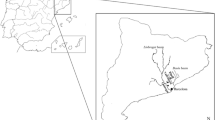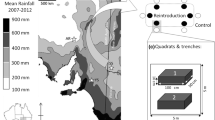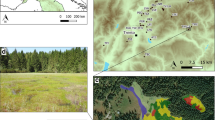Abstract
The Los Tuxtlas Biosphere Reserve in Southeastern Veracruz, Mexico represents the northernmost Neotropical lowland rainforest and has lost 84 % of its forests in the last forty years. Rich terrestrial and aquatic species communities are found throughout Neotropical forests, habitats increasingly threatened by land management practices. Plant-held waters, phytotelmata, are ecologically important discrete microhabitats harboring many specialist invertebrates and are abundant in tropical forests. In this study, using artificial tree holes, we examined invertebrate tree hole communities in a mature forest of Los Tuxtlas and in a managed habitat adjacent to the Los Tuxtlas Biological Station. Based on the proximity of human and livestock communities to managed habitats and the dispersal limitations of some phytotelmata specialists, we expected to find community composition differences between the two habitats. We found distinct differences in chironomid colonization; Tanypodinae, a predaceous subfamily, was present in the managed habitat and its omnivorous counterpart, Chironominae, was present in the forest. We found differences in mosquito colonization with more predaceous Toxorhychites in the managed habitat. Haemagogus mosquitoes were only present in the managed habitat. These results indicate different colonization ability across phytotelmata specialists and warn of larger community shifts and potential public health hazards with continued and intensified forest fragmentation and degradation.



Similar content being viewed by others
References
Anderson MJ, Walsh DC (2013) PERMANOVA, ANOSIM, and the Mantel test in the face heterogeneous dispersions: what null hypothesis are you testing? Ecol Monogr 83:557–574
Barbour MT, Gerritsen J, Snyder BD, Stribling JB (1999) Rapid bioassessment protocols for use in streams and wadeable rivers: periphyton, benthic macroinvertebrates and fish, 2nd edn. EPA 841-B-99-002. U.S. Environmental Protection Agency, Office of Water, Washington, DC, pp 202
Barlow J, Gardner TA, Araujo IS, Ávila-Pires TC, Bonaldo AB, Costa JE, Esposito MC, Ferriera LV, Hawes J, Hernandez MIM, Hoogmoed MS, Leite RN, Lo-Man-Hung NF, Malcolm JR, Martins MB, Mestre LAM, Miranda-Santos R, Nunes-Gutjahr AL, Overal WL, Parry L, Peters SL, Riberio-Junior MA, da Silvia MNF, da Silvia Motta C, Peres CA (2007) Quantifying the biodiversity value of tropical primary, secondary, and plantation forests. Proc Natl Acad Sci USA 104:18555–18560
Bihn JH, Gebauer G, Brandl R (2010) Loss of functional diversity of ant assemblages in secondary tropical forests. Ecology 91:782–792
Blakely TJ, Harding JS, Didham RK (2012) Distinctive aquatic assemblages in water-filled tree holes: a novel component of freshwater biodiversity in New Zealand temperate rainforests. Insect Conserv Divers 5:202–212
Bloom SA (1981) Similarity indices in community studies: potential pitfalls. Mar Ecol-Prog Ser 5:125–128
Burkett-Cadena ND, McClure CJ, Estep LK, Eubanks MD (2013) Hosts or habitats: What drives the spatial distribution of mosquitoes? Ecosphere 4:art30
Cayuela L, Benayas JMR, Echeverría C (2006) Clearance and fragmentation of tropical montane forests in the Highlands of Chiapas, Mexico (1975–2000). For Ecol Manag 226:208–218
Cohen ML (2000) Changing patterns of infectious disease. Nature 406:762–767
Corbet PS (1999) Dragonflies: behaviour and ecology of Odonata. Cornell University Press, Ithaca
Cummins KW, Klug MJ (1979) Feeding ecology of stream invertebrates. Annu Rev Ecol Syst 1:147–172
Delettre YR, Morvan N (2000) Dispersal of adult aquatic Chironomidae (Diptera) in agricultural landscapes. Freshw Biol 44:399–411
Díaz A, Galante E, Favila ME (2010) The effect of the landscape matrix on the distribution of dung and carrion beetles in a fragmented tropical rain forest. J Insect Sci 10:art81
Dirzo R, Garcia MC (1992) Rates of deforestation in Los Tuxtlas, a neotropical area in southeast Mexico. Conserv Biol 6:84–90
Downing JA, Duarte CM (2009) Abundance and size distribution of lakes, ponds and impoundments. Lakes (formation diversity, distribution). In: Likens GE (ed) Encyclopedia of inland waters. Elsevier, Oxford, pp 469–478
Dunn LH (1927) Observations on the oviposition of Aëdes aegypti, Linn., in relation to distance from habitations. B Entomol Res 18:145–148
Estrada A, Coates-Estrada R (1997) Anthropogenic landscape changes and avian diversity at Los Tuxtlas, Mexico. Biodivers Conserv 6:19–43
Estrada A, Anzures DA, Coates-Estrada R (1999) Tropical rain forest fragmentation, howler monkeys (Alouatta palliata), and dung beetles at Los Tuxtlas, Mexico. Am J Primatol 48:253–262
Fahrig L (2003) Effects of habitat fragmentation on biodiversity. Annu Rev Ecol Evol S 34:487–515
Fellows I (2012) Deducer: a data analysis GUI for R. J Stat Softw 49:1–15
Fincke OM (1999) Organization of predator assemblages in Neotropical tree holes: effects of abiotic factors and priority. Ecol Entomol 24:13–23
Fincke OM (2006) Use of forest and tree species, and dispersal by giant damselflies (Pseudostigmatidae): their prospects in fragmented forests. In: Rivera AC (ed) Forests and dragonflies. Pensoft, Sofia, pp 103–125
Fincke OM, Yanoviak SP, Hanschu RD (1997) Predation by odonates depresses mosquito abundance in water-filled tree holes in Panama. Oecologia 112:244–253
Flores JJ, Coates RI, Sánchez’Cordero V, Mendieta VJ (2014) Mamíferos terrestres de la estación de biología tropical de los tuxtlas. Revista Digital Universitaria 15:1–10
Frank JH, Lounibos LP (1987) Phytotelmata: swamps or islands? Fla Entomol 70:14–20
Galizzi MC, Zilli F, Marchese M (2012) Diet and functional feeding groups of Chironomidae (Diptera) in the Middle Paraná River floodplain (Argentina). Iheringia. Sér Zool 102:117–121
García BS, Luna ER (2010) Cambios demograficos en poblaciones de primates de la region sur de Los Tuxtlas, Mexico: analisis longitudinal 1985–2008. Neotrop Primates 17:1–6
Gascon C, da Williamson GB, Fonseca GA (2000) Receding forest edges and vanishing reserves. Science 288:1356–1358
Ghazoul J (2002) Impact of logging on the richness and diversity of forest butterflies in a tropical dry forest in Thailand. Biodivers Conserv 11:521–541
Gibson L, Lee TM, Koh LP, Brook BW, Gardner TA, Barlow J, Peres CA, Bradshaw CJA, Laurance WF, Lovejoy TE, Sodhi NS (2011) Primary forests are irreplaceable for sustaining tropical biodiversity. Nature 478:378–381
González SE, Dirzo R, Vogt RC (1997) Historia natural de los Tuxtlas. México: Universidad Nacional Autónoma de México, Instituto de Biología: Instituto de Ecología
Gotelli NJ, Colwell RK (2011) Estimating species richness. In: Magurran AE, McGill BJ (eds) Biological diversity: frontiers in measurement and assessment. Oxford University Press, New York, pp 39–54
Hildrew AG, Townsend CR, Hasham A (1985) The predatory Chironomidae of an iron-rich stream: feeding ecology and food web structure. Ecol Entomol 10:403–413
Ibarra-Macias A, Robinson WD, Gaines MS (2011) Experimental evaluation of bird movements in a fragmented Neotropical landscape. Biol Conserv 144:703–712
Jensen P (1987) Ecological studies of free-living aquatic nematodes. Mar Ecol Prog Ser 35:187–196
Khazan ES (2014) Tests of biological corridor efficacy for conservation of a Neotropical giant damselfly. Biol Conserv 177:117–125
Kitching RL (1971) An ecological study of water-filled tree-holes and their position in the woodland ecosystem. J Anim Ecol 40:281–302
Kitching RK (2001) Food webs in phytotelmata: “bottom-up” and “top-down” explanations for community structure. Annu Rev Entomol 46:729–760
Knaut AL (1997) Yellow fever and the late colonial public health response in the port of Veracruz. Hahr-Hisp Am Hist R 77:619–644
Kolb M, Galicia L (2012) Challenging the linear forestation narrative in the Neo-tropic: regional patterns and processes of deforestation and regeneration in southern Mexico. Geogr J 178:147–161
Larsson LC, Pruett CL, Wolfe DH, Patten MA (2013) Fine-scale selection of habitat by the Lesser Prairie-chicken. Southwest Nat 58:135–149
Lehner B, Döll P (2004) Development and validation of a global database of lakes, reservoirs and wetlands. J Hydrol 296:1–22
Leisnham PT, Slaney DP, Lester PJ, Heath ACG (2007) Mosquito density, macroinvertebrate diversity, and water chemistry in water-filled containers: relationships to land use. New Zeal J Zool 34:203–218
Lenat DR, Resh VH (2001) Taxonomy and stream ecology—The benefits of genus- and species-level identifications. J N Am Benthol Soc 20:287–298
Lips KR, Burrowes PA, Mendelson JR, Parra-Olea G (2005) Amphibian population declines in Latin America: a synthesis. Biotropica 37:222–226
Lips KR, Brem F, Brenes R, Reeve JD, Alford RA, Voyles J, Carey C, Livo L, Pessier AP, Collins JP (2006) Emerging infectious disease and the loss of biodiversity in a Neotropical amphibian community. Proc Natl Acad Sci Usa 103:3165–3170
Lopez LCS, Rodrigues PJ, Rios RI (1999) Frogs and snakes as phoretic dispersal agents of bromeliad Ostracods (Limnocytheridae: Elpidium) and Annelids (Naididae: Dero). Biotropica 31:705–708
Lovejoy TE, Bierregaard RO Jr, Rylands AB, Malcolm JR, Quintela CE, Harper LH, Brown KS, Powell AH, Powell GVN, Schubart HOR, Hays MB (1986) Edge and other effects of isolation on Amazon forest fragments. In: Soule ME (ed) Conservation biology: the science of scarcity and diversity. Sinauer Associates, Sunderland, pp 257–285
Maguire B (1971) Phytotelmata: biota and community structure determination in plant-held waters. Annu Rev Ecol Syst 2:439–464
Mamaev BM, Krivosheina NP (1996) New data on the taxonomy and biology of the family Axymyiidae (Diptera). Ent Rev Wash 45:93–99
McCune B, Grace JB, Urban DL (2002) Analysis of ecological communities, vol 28. MjM software design, Gleneden Beach
Mendoza E, Fay J, Dirzo R (2005) A quantitative analysis of forest fragmentation in Los Tuxtlas, southeast Mexico: patterns and implications for conservation. Rev Chil Hist Nat 78:451–467
Merritt R, Dadd R, Walker E (1992) Feeding behavior, natural food, and nutritional relationships of larval mosquitoes. Ann Rev Ent 37:349–374
Merritt R, Cummins K, Berg M (2008) An introduction to the aquatic insects of North America. Kendall/Hunt Publishing, Dubuque
Muñoz AT (1995) La fiebre amarilla en Mézico. Erradicación del Aëdes aegypti. Salud Publica Mexico 37:103–110
Ngai JT, Kirby KR, Gilbert B, Starzomski BM, Pelletier AJD, Conner JCR (2008) The impact of land-use on larval insect communities: testing the role of habitat elements in conservation. Écoscience 15:160–167
Oksanen J, Blanchet FG, Kindt R, Legendre P, Minchin PR, O’Hara RB, Simpson GL, Solymos P, Stevens MHH, Wagner H (2013) vegan: community ecology package. R package version 2.0-10. http://CRAN.R-project.org/package=vegan. Accessed 29 June 2015
Perfecto I, Rice RA, Greenberg R, van der Voort ME (1996) Shade coffee: a disappearing refuge for biodiversity. Bioscience 46:598–608
Proctor H, Pritchard G (1989) Neglected predators: water mites (Acari: Parasitengona: Hydrachnellae) in freshwater communities. J N Am Benthol Soc 8:100–111
R Core Development Team (2013) R version 3.0.2. R Project for Statistical Computing, Vienna, Austria. www.r-project.org
Roberts DW (2014) labdsv: ordination and multivariate analysis for ecology. R package version 1.6-1. http://CRAN.R-project.org/package=labdsv. Accessed 29 June 2015
Shaw DW, Escalante P, Rappole JH, Ramos MA, Oehlenschlager RJ, Warner DW, Winker K (2013) Decadal changes and delayed avian species losses due to deforestation in the northern Neotropics. PeerJ 1:e179
Smith DG (2001) Pennak’s freshwater invertebrates of the United States: Porifera to Crustacea. Wiley, Hoboken
Sota T, Mogi M (1996) Species richness and altitudinal variation in the aquatic metazoan community in bamboo phytotelmata from North Sulawesi. Res Popul Ecol 38:275–281
Srivastava DS, Kolasa J, Bengtsson J, Gonzalez A, Lawler SP, Miller TE, Munguia P, Romanuk T, Schneider DC, Trzcinski KM (2004) Are natural microcosms useful model systems for ecology? Trends Ecol Evol 19:284–379
Stehr FW (1991) Immature insects, vol 2. Kendall/Hunt Publishing, Dubuque
Tatem AJ, Rogers DJ, Hay SI (2006) Global transport networks and infectious disease spread. Adv Parasitol 62:293–343
Theiler M, Downs WG (1973) The Arthropod-borne viruses of vertebrates: an account of the Rockefeller Foundation Virus Program, 1951–1970. Yale University Press, New Haven
Vaca RA, Golicher DJ, Cayuela L, Hewson J, Steininger M (2012) Evidence of incipient forest transition in southern Mexico. PLoS One 7:e42309
Vandermeer J, Addicott J, Andersen A, Kitasko J, Pearson D, Schnell C, Wilbur H (1972) Observations of Paramecium occupying arboreal standing water in Costa Rica. Ecology 53:291–293
Yanoviak SP (1999) Community structure in water-filled tree holes of Panama: effects of hole height and size. Selbyana 20:106–115
Yanoviak SP (2001) Container color and location affect macroinvertebrate community structure in artificial tree holes in Panama. Fla Entomol 84:265–271
Yanoviak SP, Fincke OM (2005) Sampling methods for water-filled tree holes and their artificial analogues. In: Leather S (ed) Insect sampling in forest ecosystems. Blackwell Publishing, London, pp 168–185
Yanoviak SP, Lounibos LP, Weaver SC (2006) Land use affects macroinvertebrate community composition in phytotelmata in the Peruvian Amazon. Ann Entomol Soc Am 99:1172–1181
Acknowledgments
Thanks to R. Coates, A. Bundy, J. Bujan, T. Hallidayschult, ZEEB Journal Club, M. Patten, J. Muñoz, A. Geheber. Funding provided by OU Department of Biology and OU College of Arts and Sciences.
Author information
Authors and Affiliations
Corresponding author
Electronic supplementary material
Below is the link to the electronic supplementary material.
Rights and permissions
About this article
Cite this article
Khazan, E.S., Bright, E.G. & Beyer, J.E. Land management impacts on tree hole invertebrate communities in a Neotropical rainforest. J Insect Conserv 19, 681–690 (2015). https://doi.org/10.1007/s10841-015-9791-4
Received:
Accepted:
Published:
Issue Date:
DOI: https://doi.org/10.1007/s10841-015-9791-4




